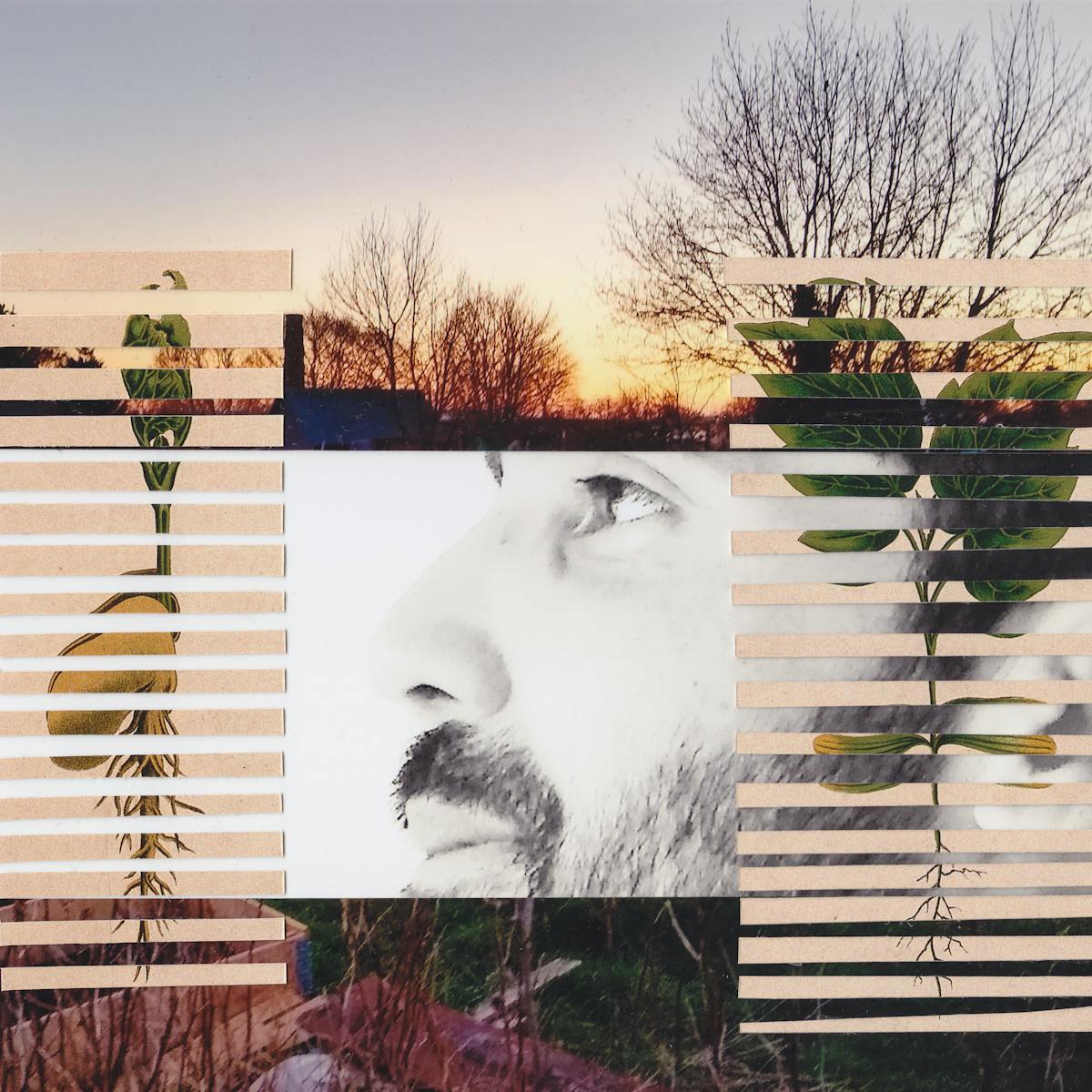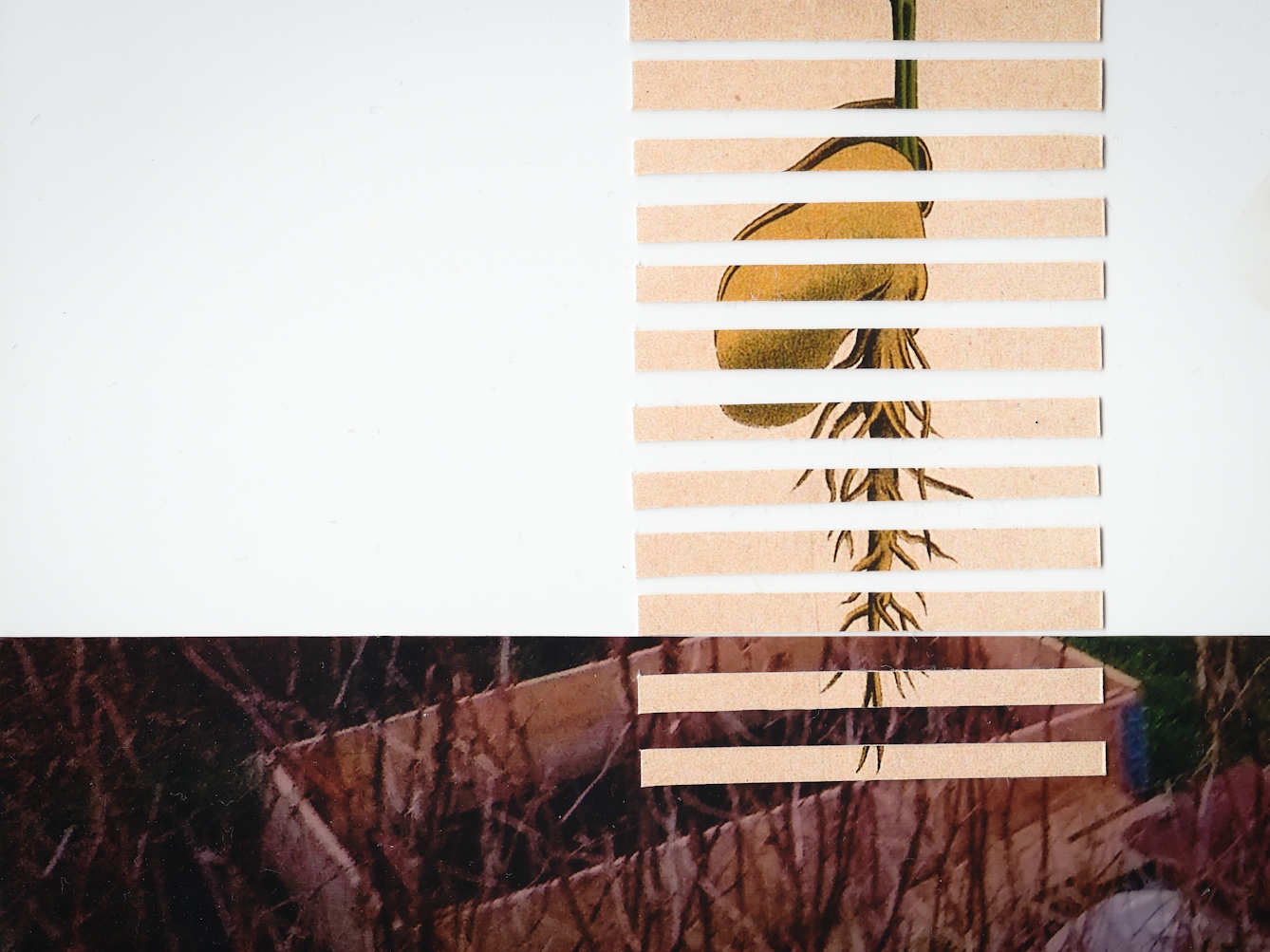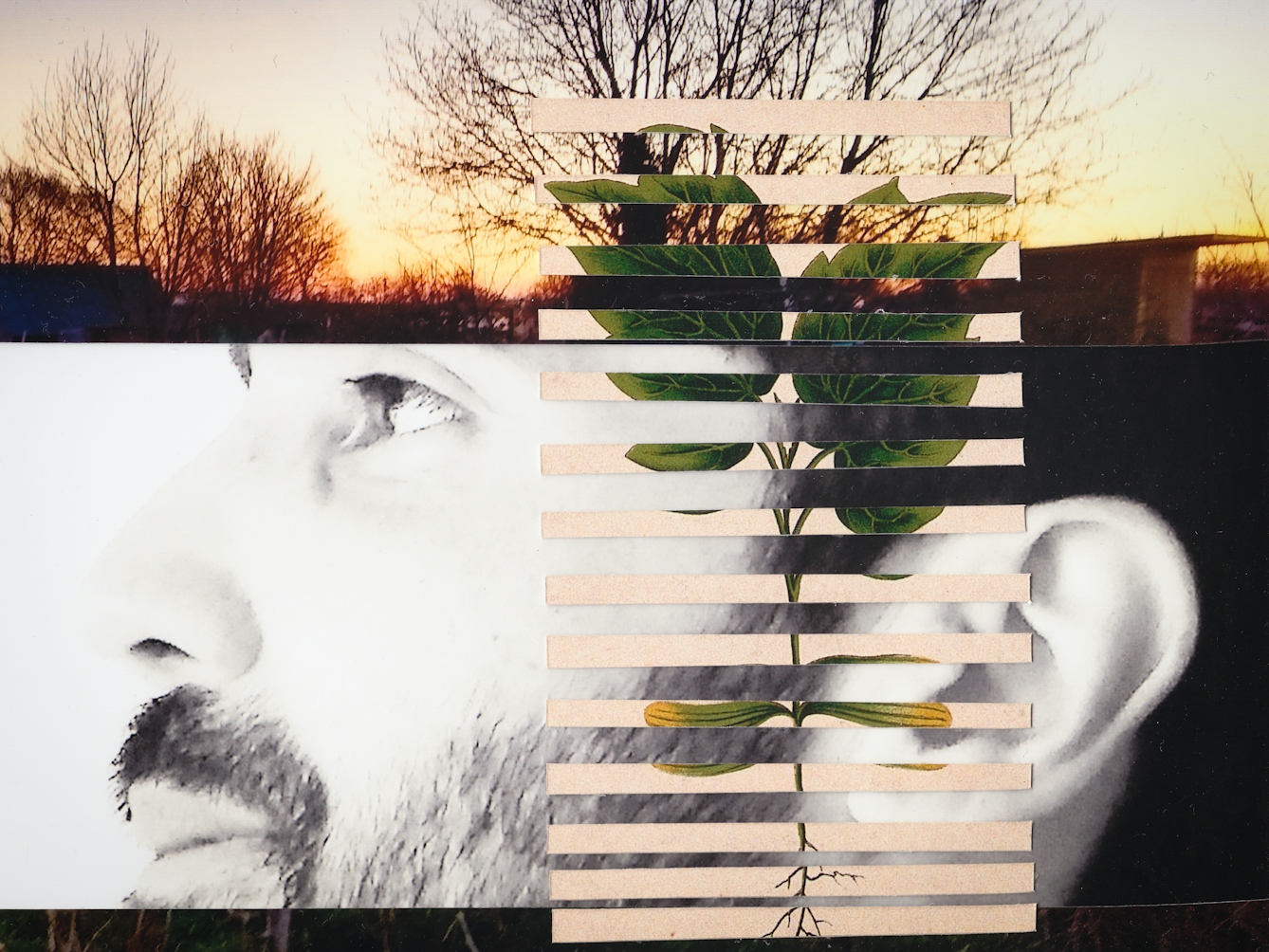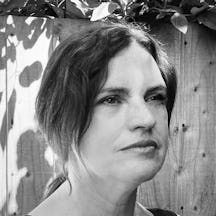How can we connect with the rhythms of the natural world? Michael Malay takes us to his Bristol allotment, where he finds that hoeing the soil offers him not just an opportunity to pay close attention to the plants and creatures that dwell there, but to time and the seasons passing.
Between two summers
Words by Michael Malayartwork by Faye Helleraverage reading time 6 minutes
- Article

It is early spring and I am at the allotment, hoeing under a daytime moon. The sun is warm against my face, the wind cool on my skin, and a gentle ache has been spreading through my body, moving down from my shoulders into the small of my back.
I lean into the hoe, sliding the blade beneath the roots of a weed, and as I push against the soil – the tendrils resist at first, then snap – the air fills with the smell of cut greenery: rank, pungent, sweet. I repeat the action, lowering the hoe, feeling it catch against more roots, and as I move across the plot, bringing up weed after weed, something in me also begins to loosen: a tightness, a tension; the weight of the week.
I walk to the shed, where I take a few glugs from a bottle of beer. Then I mop my brow and pick up the hoe again. There are more hours of work ahead, but no hurry. The day is roomy yet.
I have come to clear the vegetable patch. At home, some squash seedlings have been sitting by the kitchen window, drinking in the light, and soon it will be time to transplant them. We sowed them in late February, when the land was beginning to thaw, and then watched and waited for the first shoots to appear.
A week passed, then another, but the pots remained unchanged. Had we put too much water in the soil, we wondered? Or was the kitchen too cold? No, we were just being impatient. For the next morning, two green shoots appeared, wearing the husk of the seeds as tiny hats.
So the world isn’t broken, I remember thinking. The light was coming back. The next day, two more seedlings appeared, and the day after we found several more. Finally, the green fuse had been lit and now it couldn’t be stopped.

“It is early spring and I am at the allotment, hoeing under a daytime moon.”
I stand over the hoe and angle the blade into the soil. I haven’t worked on the allotment since November, and in the intervening months the vegetable patch has been reclaimed by weeds: dock, couch grass, fat hen. It will take a week to clear the ground, and then months of vigilance to keep the plot in shape.
But I don’t mind – for I like hoeing. I’d long liked the feel of the hoe in my hand – its lightness, the wit of its construction – and the rasping of the blade against the soil. It was a vernacular tool, homely and snug against the body, and as I worked with it, eyes on the ground, shoulders moving in a gentle rhythm, something in me would change.
How repetition calms the mind
My thoughts would fall away, as if siphoned from my skull into the shaft of the hoe, and after hours of working in this manner, my thoughts would slow to a trickle. Then the hoe would become a thinking thing, licking up the weeds with its own intelligence, while I became a piece of feeling wood: a wooden arm tipped with metal.
I liked that. The feeling of disappearing into the work; the hoe’s repetitive rhythm. It was as though the circumference of my body had doubled – I could now reach the weeds with the long arm of my mind – even as my usual self (that anxious, doubting thing) had become smaller and smaller. Reach down and sweep across; now feel the push of earth, but let the shaft take the strain. Repeat a thousand times.
I return to the shed and take a few more sips of beer. Across the lane, a magpie sits on an apple tree, chattering from its perch, and next to my neighbour’s shed, behind a tangle of bramble, I can see the snout of the resident fox. I scoff down a handful of salted peanuts, and then, as I lean my beer against the shed, and as my shadow falls across a patch of nettles, something twitches beneath me.
At first I think it’s a filament of grass, picked up and tossed aside by the wind. But when it moves again, I realise it’s something else.

“My thoughts fall away, as if siphoned from my skull into the shaft of the hoe.”
I kneel down and scan the ground. Then I see it: a tiny, sandy-brown thing. My first grasshopper of the year. It is no longer than my thumbnail, and as I lean over to inspect it, it seems to shrink pitifully into its frame. Its eyes are fixed and impassive. It is strangely, delicately put together. It seems too small for this big world. I cup it in my hands, wanting to see it better, but when it begins to panic, bouncing frantically against my palms, I let it go.
Yesterday it might have been an egg clinging to a stalk of grass. In the autumn, seven or eight months away, it will be dead. In the meantime, it has work to do, in this one spring and summer of its life. It will be singing from the verges in several weeks, busy with the labour of life: fighting and mating, fighting and mating.
I put the hoe away. There is always more work to do, always more weeding to be done, but my arms are tired now, and the rest can wait for another day. I lie down on the grass, hat perched on my face, skin soaking up the light. At ground level the soil is fresh and sweet against the nose, and the grass feels cool against my neck. I listen to the sounds around me – my neighbours talking across the lane, the chattering of the magpie – and begin to cast my mind towards the coming summer.
The sounds of summer
In a few weeks this allotment will be alive with the clicking of grasshoppers and the pulsings of crickets, and the music will swell and swell, before reaching its pitch in the summer. And for a moment, as I imagine the allotment on a day in late July, I find myself inhabiting two seasons at once – the summer just gone, and the summer to come.
I think of the seedlings at home, growing brightly in the kitchen; and I think of last year’s squash, which must have been nourished by some miracle rain, so large and shapely did they grow.
And as I think of the green of growing things, their songs come back to me – the songs of grasshoppers on the allotment as I hoed in the noonday heat, and the songs of crickets in the evenings as I walked home in the gathering dusk; and now, lying there on the grass, my head begins to crackle again with their music, whirring with the combined music of two summers – the summer that has gone for good, and the summer that is waiting for us, a few bends upriver, like a gift.
Crick, crick, crick!
About the contributors
Michael Malay
Michael Malay is a teacher and writer based in Bristol. His work has appeared in The Willowherb Review, The Clearing, Caught by the River, and on BBC Radio 4. His first non-fiction book, ‘Late Light’, will be published in 2023.
Faye Heller
Faye Heller studied for her MA in Fine Art at the Slade School, University College London, UK and is a qualified teacher. She has been making artwork for over 25 years and her work was shown at the Tate Modern on a late night for the Dora Maar exhibition in 2020. Using handmade photomontage and collage, she combines portraiture with the natural and man-made landscape, exploring the psychological and environmental, and evoking layers of time, landscape, places and encounters.

